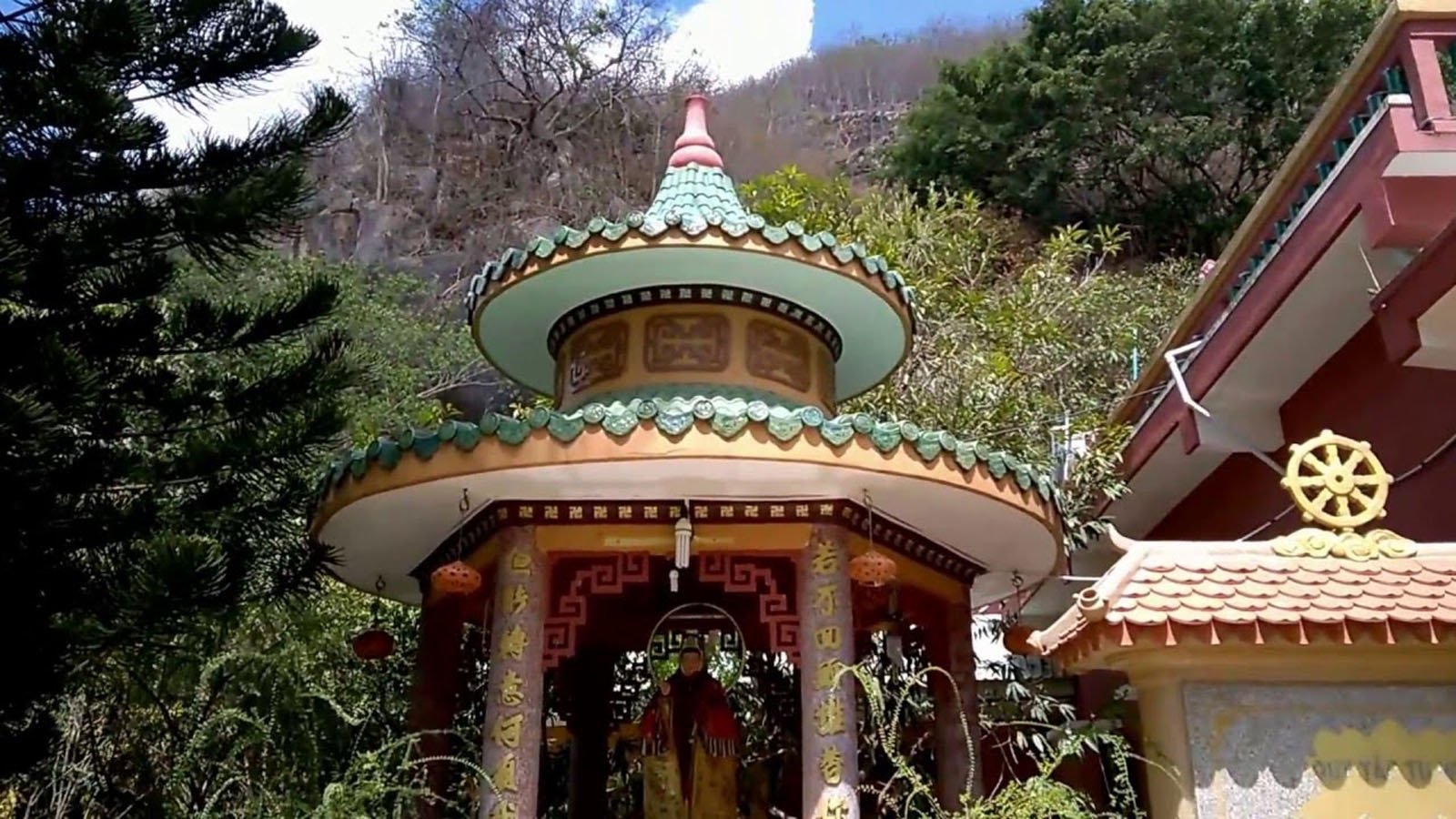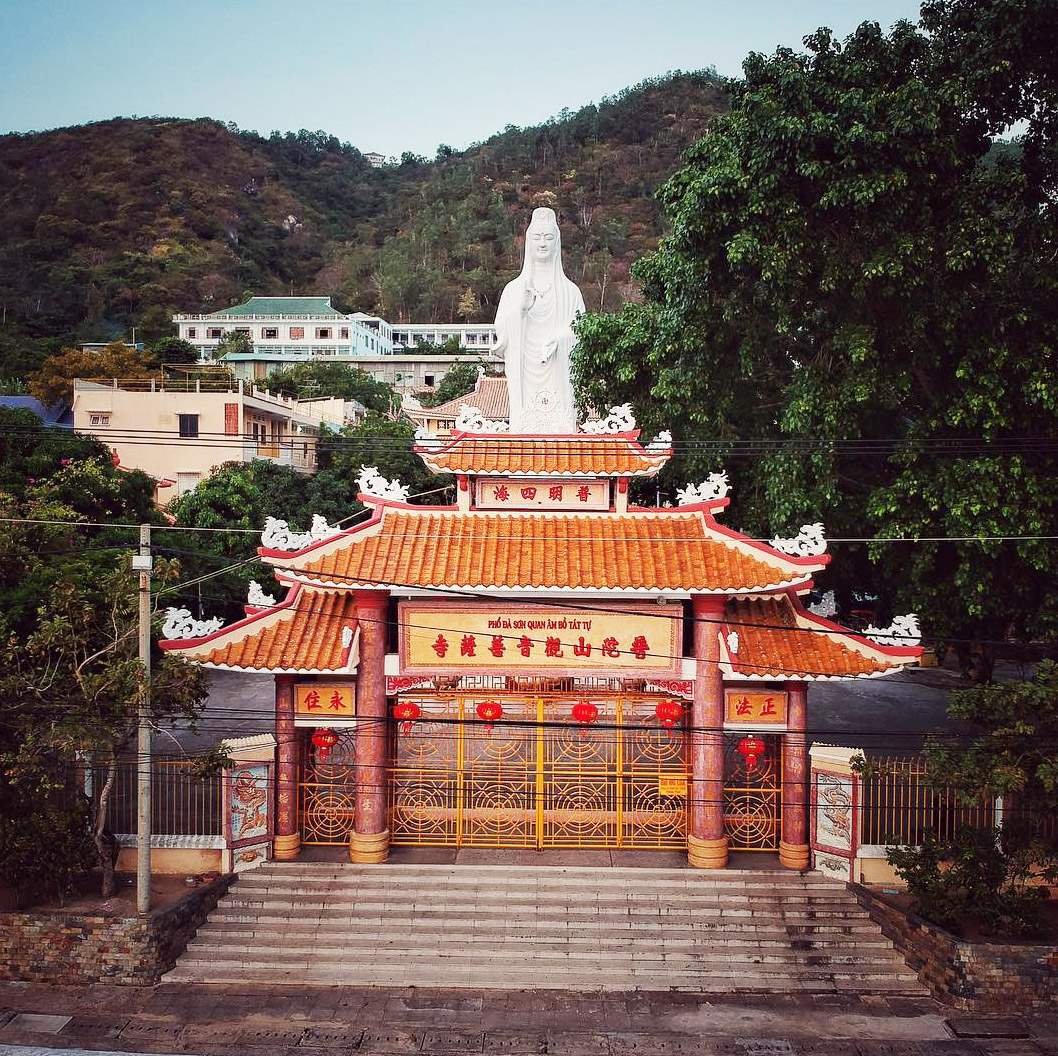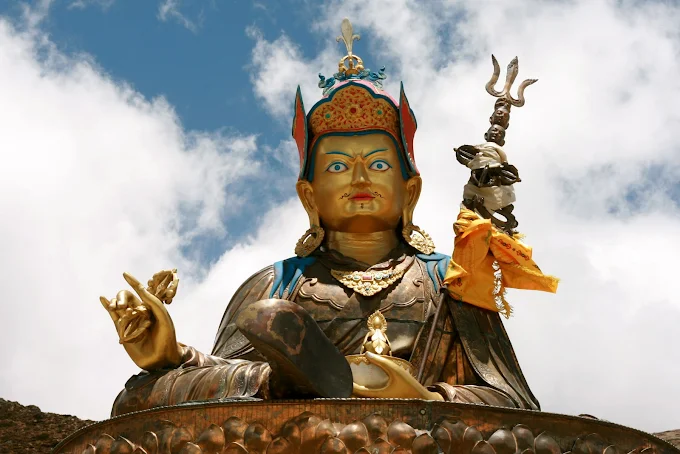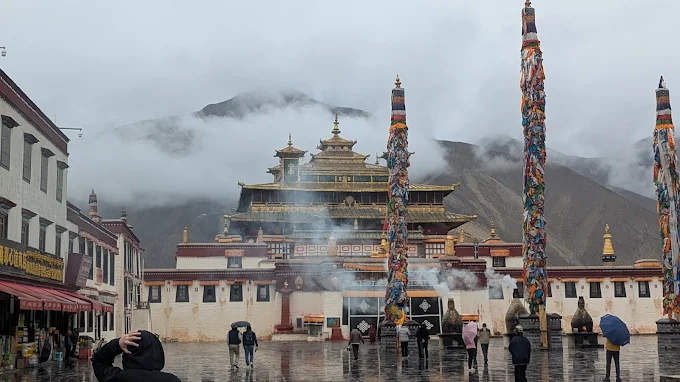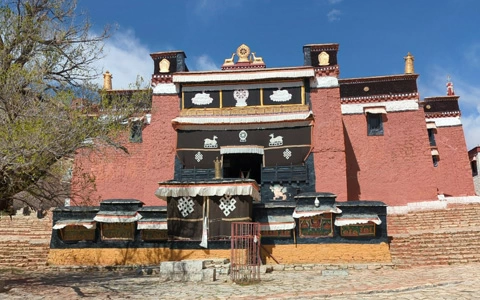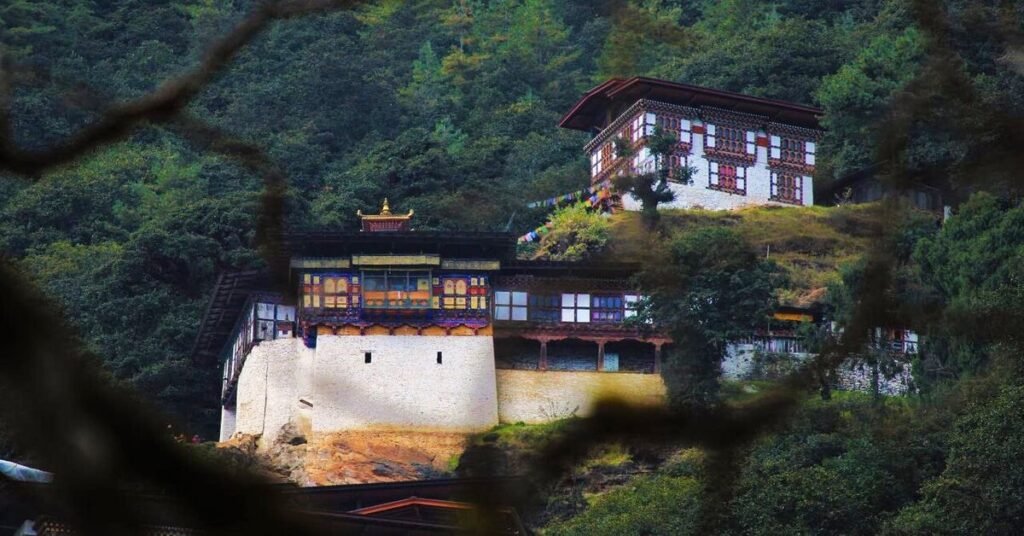Quan The Am Bodhisattva Pagoda: The Sea-Gazing Mercy of Vũng Tàu’s Lotus Relic
As twilight bathes Vũng Tàu’s Bãi Dâu Beach, Quan The Am Bodhisattva Pagoda glows softly, its 16-meter Avalokitesvara statue standing sentinel over the East Sea, a beacon of compassion atop a lotus pedestal. The air hums with Amitabha chanting, devotees seeking rebirth in Amitabha’s Western Paradise, their voices blending with sandalwood incense and the rhythmic pulse of waves below. A lotus bloom sways in the courtyard’s tranquil pond, mirroring the pagoda’s ornate roof, etched with bao lam carvings, a national relic of Vietnamese artistry. This Mahayana sanctuary invites all to embrace its sea-gazing serenity and timeless devotion.
Overview and Significance
Introduction to Quan The Am Bodhisattva Pagoda
Quan The Am Bodhisattva Pagoda, perched near Bãi Dâu Beach in Vũng Tàu, stands as a revered Mahayana Buddhist temple, its 16-meter Avalokitesvara statue embodying the mercy of the Pure Land tradition, which centers on devotion to Amitabha Buddha for rebirth in his Western Paradise. Located 4 kilometers from Vũng Tàu’s city center at 164 Trần Phú, Ward 5, this early 20th-century pagoda, recognized as a national historical-cultural relic, blends Vietnamese Mahayana elegance with intricate bao lam carvings. Its sea-facing statue, historic main hall, and vibrant rằm ceremonies make it a cultural beacon, drawing pilgrims, tourists, and scholars into a realm of coastal spirituality.
Historical Journey
Quan The Am Bodhisattva Pagoda, also known as Phổ Đà Sơn Quan Âm Bồ Tát Tự, was founded in the early 20th century by local Mahayana Buddhists to serve Vũng Tàu’s coastal community. Built with community donations, it was designed with a sea-facing orientation, symbolizing Avalokitesvara’s protection over fishermen. The 16-meter Avalokitesvara statue, completed in the mid-20th century, became its centerpiece, while the main hall’s bao lam carvings earned national relic status in the 1990s. Renovations in the 1980s preserved its historic charm, adding meditation spaces.
Through Vũng Tàu’s evolution as a coastal hub, the pagoda has remained a spiritual refuge, its history reflecting Vietnam’s devotion to Avalokitesvara and maritime heritage.
- Patronage: Supported by local Mahayana Buddhists and Vietnam Buddhist Sangha.
- Milestones: Founded early 20th century; Avalokitesvara statue completed mid-20th century; national relic status in 1990s.
Cultural Significance
Quan The Am Bodhisattva Pagoda is a vital hub for Vũng Tàu’s Mahayana community, nurturing devotion to Avalokitesvara and Shakyamuni Buddha. Its Pure Land practices, centered on Amitabha chanting, offer solace to devotees and fishermen seeking safety at sea. The pagoda hosts cultural events, like rằm (full moon) ceremonies and Tet celebrations, drawing crowds to its sea-facing grounds.
Regionally, it connects with Mahayana communities in southern Vietnam, sharing Pure Land teachings. Globally, it attracts scholars studying Vietnamese Buddhist relics and pilgrims drawn to its coastal serenity, offering a glimpse into Mahayana’s compassion and Vietnam’s maritime culture.
- Mahayana Hub: Preserves Pure Land practices in Vũng Tàu.
- Cultural Role: Hosts rằm ceremonies and Tet celebrations.
- Global Appeal: Attracts scholars and pilgrims for its relic and coastal setting.
Unique Legacy
The pagoda’s 16-meter Avalokitesvara statue and bao lam carvings define its legacy, embodying Mahayana’s mercy. The sea-facing statue, a protector of fishermen, and the carvings’ intricate flora and fauna symbolize divine harmony. Vietnamese lotus motifs and coastal design reflect local syncretism, while statues like Shakyamuni Buddha anchor spiritual devotion.
This fusion of monumental sculpture, cultural relics, and coastal grace earns Quan The Am Bodhisattva Pagoda its title as the “Sea-Gazing Mercy of Vũng Tàu’s Lotus Relic,” a timeless sanctuary of faith.
- Avalokitesvara Statue: 16-meter sea-facing icon.
- Bao Lam Carvings: National historical-cultural relic.
- Cultural Syncretism: Vietnamese Mahayana influences.
Community and Global Impact
Quan The Am Bodhisattva Pagoda thrives as a communal heart for Vũng Tàu’s coastal community. On rằm days, devotees gather before the Avalokitesvara statue to chant and offer incense, their prayers carried by sea breezes. Charity drives, supporting local fishermen, strengthen community bonds, while Tet celebrations draw crowds with offerings and dragon dances.
Globally, the pagoda attracts cultural tourists and scholars studying its national relic carvings. The Vietnamese diaspora supports preservation efforts, reinforcing cultural ties. Its sea-facing statue and historic status cement its global role as a Mahayana cultural haven.
- Local Engagement: Hosts prayers, charity, and festivals.
- Global Reach: Draws tourists and scholars worldwide.
- Diaspora Support: Funded by Vietnamese communities abroad.
Architectural and Spiritual Features
Iconic Design
Quan The Am Bodhisattva Pagoda’s architecture blends Mahayana grandeur with Vietnamese coastal elegance, its 1,500-square-meter complex centered on the main hall, 16-meter Avalokitesvara statue, and serene courtyard, framed by lotus ponds and bodhi trees. Its vibrant palette—gold, red, and white—celebrates Mahayana’s divine radiance, with Vietnamese tiled roofs and bao lam carvings harmonizing with the sea’s rhythmic pulse.
The sea-facing statue’s lotus pedestal and the main hall’s ornate carvings, rooted in Mahayana traditions, craft a sacred oasis of devotion and awe, offering tranquil coastal vistas.
- Avalokitesvara Statue: 16-meter sea-facing icon.
- Vietnamese Aesthetic: Tiled roofs and bao lam carvings.
- Coastal Oasis: Harmonizes with Bãi Dâu’s sea views.
Key Structures
The main hall, housing revered statues, is the pagoda’s spiritual heart, its bao lam carvings glowing under soft light. The 16-meter Avalokitesvara statue, standing on a lotus pedestal, dominates the courtyard, facing the East Sea. The courtyard, with lotus ponds and bodhi trees, serves as a communal space for ceremonies. A small meditation pavilion, adorned with ceramic tiles, offers quiet reflection, while a stone stupa houses relics, adding spiritual depth.
These structures, blending spiritual and architectural beauty, create a serene Mahayana sanctuary.
- Main Hall: Spiritual heart with bao lam carvings.
- Avalokitesvara Statue: 16-meter lotus pedestal icon.
- Courtyard: Communal space with lotus ponds.
Worshipped Statues
The main hall’s Avalokitesvara statue, a white porcelain figure with a nectar vase, radiates compassion, complementing the larger outdoor statue. Shakyamuni Buddha, gilded and seated on a lotus pedestal, symbolizes enlightenment, its serene gaze anchoring worship. Smaller shrines house Maitreya, in gold leaf with a joyful smile, symbolizing future prosperity, and Ksitigarbha (Địa Tạng [地藏]), in jade with a staff, guiding souls from suffering.
These statues, central to Mahayana worship, embody the pagoda’s spiritual essence, their iconography fostering devotion.
- Avalokitesvara: Porcelain, offering compassion.
- Shakyamuni Buddha: Gilded, symbolizing enlightenment.
- Ksitigarbha: Jade, guiding souls from suffering.
Materials and Techniques
The main hall, crafted with polished granite and ceramic tiles, showcases Vietnamese artisans’ mastery, its bao lam carvings of flora and fauna reflecting intricate woodwork recognized as a national relic. The outdoor Avalokitesvara statue, made of reinforced concrete and painted white, ensures durability against coastal winds. Stone carvings of Buddhist tales adorn the courtyard, blending Vietnamese craftsmanship with Mahayana iconography. The tiled roof, with dragon patterns, adds elegance, a hallmark of early 20th-century coastal architecture.
These materials, grounded in Vietnamese syncretism, create a visually striking and spiritually resonant sanctuary.
- Granite Hall: Ceramic-tiled with bao lam carvings.
- Concrete Avalokitesvara: White-painted for durability.
- Stone Carvings: Vietnamese Buddhist tales.
Signature Elements
The 16-meter Avalokitesvara statue and bao lam carvings are the pagoda’s signature elements, their mercy symbolizing Mahayana devotion. The statue’s sea-gazing stance, glowing under festival lights, and the carvings’ intricate artistry anchor cultural reverence. Vietnamese altars, with red and gold accents, frame the statues, enhancing their spiritual presence.
These elements, blending monumental sculpture and cultural relics, define Quan The Am Bodhisattva Pagoda’s Mahayana identity, captivating all who visit.
- Avalokitesvara Statue: 16-meter sea-facing icon.
- Bao Lam Carvings: National relic woodwork.
- Vietnamese Altars: Vibrant frames for statue worship.
Lesser-Known Features
The main hall’s ceiling, painted with lotus murals, forms a meditative canopy, often unnoticed in soft light. The courtyard’s stone lanterns, inspired by Vietnamese designs, cast gentle glows at dusk. Smaller shrines house ceramic sutra tablets with Hán script, offering spiritual insight. A koi pond near the entrance, with lotus blooms, adds serene beauty, reflecting the pagoda’s tranquil depth.
These subtle details enrich Quan The Am Bodhisattva Pagoda’s spiritual allure, rewarding attentive visitors.
- Lotus Murals: Meditative ceiling in the main hall.
- Stone Lanterns: Vietnamese-style courtyard glow.
- Koi Pond: Serene entrance feature.
Preservation and Evolution
The pagoda’s granite structures withstand Vũng Tàu’s coastal humidity, but the bao lam carvings require periodic restoration by artisans. Volunteers maintain the courtyard, stupa, and statue altars. Renovations in the 1980s preserved the national relic status, adding the meditation pavilion to enhance accessibility, ensuring the pagoda’s early 20th-century heritage endures.
These efforts keep Quan The Am Bodhisattva Pagoda a vibrant Mahayana temple, balancing tradition with modernity.
- Maintenance: Periodic carving restoration.
- Modern Updates: Meditation pavilion added in 1980s.
Rituals and Practices
Daily Sacred Rites
Each morning, Quan The Am Bodhisattva Pagoda resonates with Amitabha chanting, led by monks before the indoor Avalokitesvara statue, invoking rebirth in the Western Paradise. Devotees offer incense at the incense house, their prayers rising before Shakyamuni Buddha’s serene gaze. The meditation pavilion’s bell tolls, grounding worshippers in devotion.
Lay followers present lotus flowers and candles to Bodhisattva statues, bowing in reverence. The courtyard pond invites serene sutra recitation, fostering Mahayana’s universal salvation.
- Morning Chanting: Amitabha chanting before statues.
- Incense Offerings: Prayers for rebirth in the Pure Land.
- Sutra Recitation: Quiet pond-side devotion.
Unique Practices
The pagoda’s Pure Land devotion centers on Amitabha chanting, guiding devotees toward rebirth in the Western Paradise. Monks lead daily sessions before the Shakyamuni Buddha statue, cultivating mindfulness. Vegetarian offerings, placed in ornate bowls before Avalokitesvara, emphasize merit-making, reflecting Vietnamese Mahayana traditions.
On rằm days, monks perform sea-prayer ceremonies before the outdoor Avalokitesvara statue, unique to the pagoda’s coastal setting, blessing Vũng Tàu’s fishermen for safety and prosperity, tied to its sea-gazing legacy.
- Pure Land Chanting: Daily Amitabha sessions.
- Vegetarian Offerings: Merit-making before statues.
- Sea-Prayer Ceremonies: Rằm rituals for fishermen.
Festival Traditions
Rằm ceremonies, held on full and new moon days, transform Quan The Am Bodhisattva Pagoda with devotees offering lotus flowers before the Avalokitesvara statue, as monks chant for blessings. Vu Lan, honoring filial piety, draws crowds pinning roses—red for living parents, white for the deceased—before the statues, with ancestral liberation prayers. Tet brings dragon dances and red envelope offerings, blending Mahayana devotion with Vietnamese festivity. Vesak, celebrating Buddha’s life, features candlelit processions and offerings to Shakyamuni Buddha.
Lunar days attract pilgrims for special Amitabha chanting sessions, with statue veneration by the sea, uniting the community in reverence.
- Rằm Ceremonies: Lotus offerings and blessings before Avalokitesvara.
- Vu Lan: Rose-pinning and chanting for ancestors.
- Tet: Dragon dances and red envelope offerings.
Visitor Engagement
Visitors can light incense or offer lotus flowers before Avalokitesvara at the incense house, guided by monks on Mahayana etiquette. Amitabha chanting sessions, open to all, allow participation in Pure Land practices. During rằm ceremonies, tourists may offer candles before the statues, immersed in spiritual rituals.
The sea-facing statue fosters cultural exchange, with monks sharing insights on Avalokitesvara’s protection, connecting locals and global visitors.
- Incense Lighting: Guided offerings before Avalokitesvara.
- Amitabha Chanting: Open Pure Land sessions.
- Festival Participation: Candle offerings during rằm ceremonies.
Spiritual Community Roles
Quan The Am Bodhisattva Pagoda’s monks, trained in Mahayana Pure Land teachings, lead chanting sessions and mentor devotees. They organize charity drives, supporting Vũng Tàu’s fishermen, strengthening community ties. Lay volunteers maintain the courtyard, stupa, and statue altars, fostering a sense of unity.
The abbot delivers sermons on compassion before Avalokitesvara, guiding initiatives. Buddhist devotee groups (Phật tử) organize rằm ceremonies and Tet events, enriching communal life.
- Monks: Lead rituals, mentor, and organize charity.
- Lay Volunteers: Maintain courtyard and statue altars.
- Buddhist Devotees: Organize rằm ceremonies and Tet celebrations.
Visitor Information
Navigating to Quan The Am Bodhisattva Pagoda
Quan The Am Bodhisattva Pagoda is located at 164 Trần Phú, Phường 5, Vũng Tàu City, its 16-meter Avalokitesvara statue a striking landmark near Bãi Dâu Beach, approximately 500 meters away. The nearby Large Mountain, a 5-minute drive, offers scenic trails, while Vũng Tàu’s city center, with landmarks like the Christ the King Statue, is a 10-minute taxi ride. The pagoda blends coastal serenity with urban accessibility, its sea-facing statue visible along the main Trần Phú road, distinct from Chùa Quan Âm Các in Hẻm 542 Trần Phú.
From the city center, visitors can take a taxi or motorbike via Trần Phú, following the coastal road toward Bãi Dâu. Look for the white Avalokitesvara statue on the right, with Núi Lớn (Large Mountain) as a backdrop.
- Landmark: 16-meter Avalokitesvara statue near Bãi Dâu Beach.
- Nearby Sites: Large Mountain (2 km), Christ the King Statue (4 km), Bãi Dâu Beach (0.5 km).
- Central Access: 10-minute taxi from city center.
Address of Quan The Am Bodhisattva Pagoda
- Vietnamese: Chùa Quan Thế Âm Bồ Tát (Phổ Đà Sơn Quan Âm Bồ Tát Tự), 164 Trần Phú, Phường 5, Thành phố Vũng Tàu, Tỉnh Bà Rịa – Vũng Tàu, Việt Nam.
- English: Quan The Am Bodhisattva Pagoda, 164 Trần Phú, Ward 5, Vũng Tàu City, Bà Rịa – Vũng Tàu Province, Vietnam.
Visiting Hours and Etiquette
Quan The Am Bodhisattva Pagoda is open daily from 6:00 AM to 7:00 PM, with early mornings offering a peaceful setting for chanting before the statues. The main hall, courtyard, and meditation pavilion are accessible daily, with guided visits during rằm (full moon) ceremonies. Visitors should plan 1–2 hours to explore the complex and enjoy sea views from the statue’s base.
Dress modestly, covering shoulders and knees, and remove shoes before entering the main hall or meditation pavilion. Photography is permitted in the courtyard but requires permission inside shrines. Bow three times before statues to show respect, adhering to Mahayana customs.
- Hours: 6:00 AM–7:00 PM daily.
- Access: Main hall and courtyard open daily; guided during ceremonies.
- Etiquette: Modest dress, remove shoes, bow before statues.
Accessibility and Safety
The pagoda offers flat pathways and ramps to the courtyard and main hall, suitable for wheelchairs. The meditation pavilion’s steps may limit access, but volunteers assist during rằm ceremonies, guiding visitors to statue altars. The compact grounds accommodate mobility-impaired guests comfortably.
Vũng Tàu is safe, but coastal winds can be strong—secure loose items. Stay on designated paths to avoid uneven terrain, and bring light clothing for the region’s humidity. Be cautious of traffic on Trần Phú, a busy coastal road.
- Accessibility: Ramps and flat pathways; steps to meditation pavilion.
- Safety: Secure items; stay on paths; watch for traffic.
- Assistance: Volunteers available during ceremonies.
Amenities and Surroundings
Quan The Am Bodhisattva Pagoda provides restrooms, drinking water, and shaded benches in the courtyard. A kiosk sells incense and lotus flowers for statue offerings, supporting maintenance. The lotus pond and koi fish create tranquil spots, enhancing the spiritual ambiance.
Trần Phú offers seafood stalls and cafes, while Bãi Dâu Beach, a 2-minute walk, provides dining and relaxation. The nearby Thich Ca Phat Dai Pagoda, a 5-minute drive, offers additional spiritual exploration with its narrative gardens, enriching the cultural experience.
- Amenities: Restrooms, water, incense kiosk.
- Surroundings: Seafood stalls, Bãi Dâu Beach (0.5 km), Thich Ca Phat Dai Pagoda (1 km).
- Sensory Highlights: Sea breezes, incense, coastal calm.
Immersive Visitor Tips
Arrive at 6:00 AM to join Amitabha chanting before the indoor Avalokitesvara statue, fostering mindfulness. During rằm ceremonies, offer a lotus flower before the outdoor Avalokitesvara statue and participate in a sea-prayer ritual, immersing in coastal blessings. Photograph the statue at sunrise, its white form glowing against the sea, but avoid flash in shrines.
Stroll Bãi Dâu Beach for fresh seafood or visit Thich Ca Phat Dai Pagoda to explore its Lumbini Garden. Attend on rằm days for sea-prayer ceremonies and statue veneration, deepening your spiritual connection.
- Morning Chanting: Join Amitabha sessions early.
- Sunrise Photography: Capture the statue’s sea view.
- Festival Immersion: Offer lotuses during rằm ceremonies.

